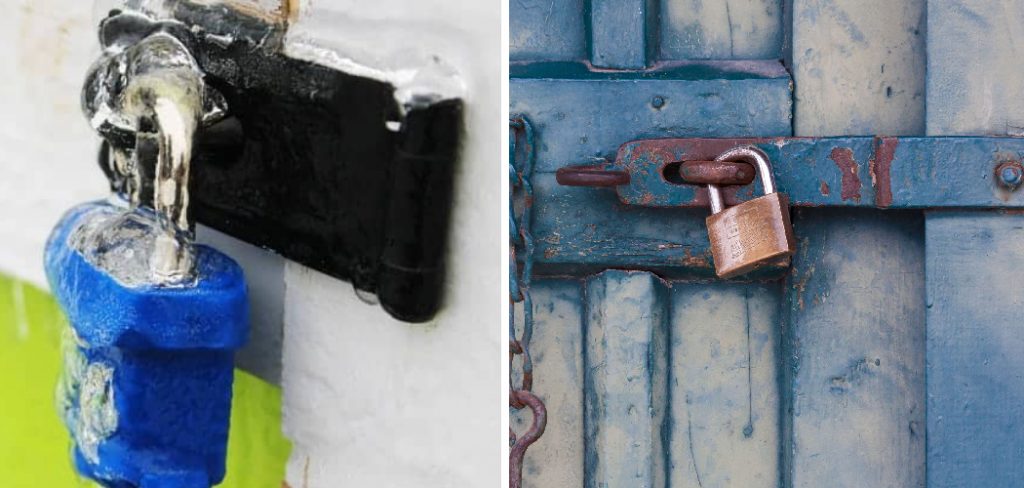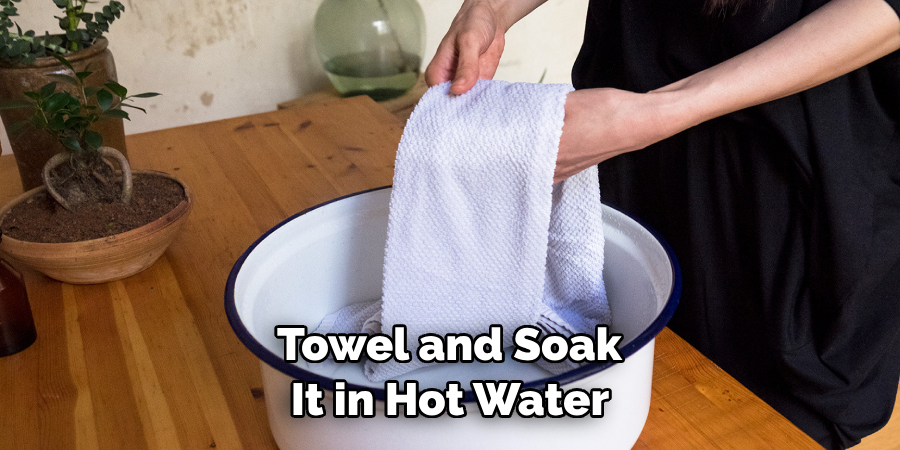Winter can be a challenging season, especially when it comes to using locks on your doors or vehicles. The moisture generated from snow, ice, or even rain can cause your locks to freeze and become impossible to unlock.

This situation can be frustrating, especially when you are in a hurry. In this blog post, we will show you how to defrost a lock like a pro. We will provide you with valuable tips and hacks that will save you time, energy, and money.
Can You Defrost a Lock?
Imagine stepping out into the freezing winter air, ready to start your day, only to find that your lock has frozen overnight. Frustration can set in quickly as you try to wiggle your key into the stubborn, icy lock. But fear not, for there are ways to defrost a lock without causing damage. One option is to use a hair dryer on its lowest setting to warm up the lock and melt the ice.
Another method involves using a de-icing spray, which can be found at hardware stores. Whatever method you choose, just remember to be patient and gentle as you work to defrost your lock.
Why Should You Defrost a Lock?
Locks can be finicky creatures. Sometimes they work perfectly, and other times they seem to refuse any attempt to open them. In particularly cold weather, locks can even become frozen shut. That’s why it’s important to defrost a lock before trying to force it open.
Not only does attempting to force it open risk damaging the lock or the key, but it’s also often an exercise in futility. Simply put, a frozen lock won’t open until it’s been defrosted. Fortunately, there are a few tips and tricks you can use to defrost a lock quickly and safely, and they’re well worth the time and effort.
How to Defrost a Lock Like a Pro: in 7 Ways
1. Using Warm Water
One of the most common methods for defrosting a lock is by using warm water. However, you need to be careful when doing this, as hot water can cause damage to your lock. Boiling water is particularly dangerous since it can warp or melt the metal. Instead, use lukewarm water and pour it slowly over the lock.

You can also use a kettle or a portable heating device to heat water before pouring it. After pouring the water on the lock, wiggle the key a bit to help the heat penetrate, and then try unlocking the lock.
2. Using a Lighter
Another remedy for defrosting a lock is using a lighter. You can use a lighter to heat the lock gently. However, you need to be cautious when using this method since a lighter can be dangerous if not used correctly.
Therefore, put a coat hanger or a metal rod into the flame until it heats up, then insert it into the lock. Move the metal back and forth a bit in the lock until the heat begins to defrost the ice. Remember, never touch the hot metal with bare hands.
3. Using De-Icer
De-icer sprays are readily available in hardware or automotive stores. De-icer can work wonders in defrosting your hard-to-open lock. Apply the spray on and around the lock, and then insert the key and try to unlock the lock. De-icer works better than water or steam since it does not freeze as quickly as regular water.
4. Using a Hairdryer
A hairdryer can also be a handy tool for defrosting a lock. Point the hairdryer to the lock and let the warm air blow directly onto the lock. Keep the hairdryer a safe distance away from the lock to prevent the heat from getting too high and causing damage to the lock. You can increase the heat of the hairdryer by setting it to a high setting to allow for faster melting of the ice.
5. Using a Vacuum Cleaner
A vacuum cleaner can also provide a powerful suction that will help to defrost your lock. Take the hose of the vacuum cleaner and put it over the frozen lock. Then turn on the vacuum cleaner and let it run for a minute or two to allow time for the suction to loosen up the ice. Once done, try unlocking the lock again.
6. Using a Hot Towel

A hot towel can also be used to defrost your lock. Take a towel and soak it in hot water. Then wrap the wet towel around the lock, making sure that it is completely covered. Allow the heat from the towel to penetrate into the frozen lock for several minutes before attempting to unlock it again.
7. Prevention
The best way to avoid the stress of having to defrost your lock is by preventing it from freezing in the first place. This step prevents the ice from forming inside your locks. Using a quality lock lubricant can help keep the lock moving smoothly and reduce the chances of the lock freezing or jamming. Avoid using hot water or other tools to melt ice since these actions can damage the lock and make the problem worse.
5 Considerations Things When You Need to Defrost a Lock
1. Temperature
When defrosting a lock, it is important to consider the temperature of the environment. If the temperature is too cold, the lock may not be able to be opened as easily. It is best to defrost a lock in a warm room or by using a hairdryer set on low heat.
2. Moisture

Moisture can cause ice to form inside of locks, making it difficult for them to open. To prevent this from happening, it is important to use a dehumidifier or an absorbent material such as cat litter to draw moisture away from the lock before attempting to defrost it.
3. Time
Depending on how frozen the lock is, it may take some time for it to thaw out enough for you to open it. It is important to be patient and give the lock time so that you don’t damage it while trying to open it before it has had enough time to thaw out completely.
4. Tools
You may need certain tools in order to successfully defrost your lock depending on what type of lock you have and how frozen it is. For example, if your lock has been exposed to extreme temperatures for an extended period of time, you may need an electric drill in order to break through any ice that has formed inside the keyhole or tumblers.
5. Safety
Lastly, when attempting to defrost a lock, safety should always be your top priority. Be sure that you are wearing protective gloves and eye protection in case any pieces of ice fly off during the process and potentially cause injury or damage to other objects around you.
5 Benefits of Defrost a Lock
1. Improved Security
Defrosting a lock can significantly improve the security of your home or business. By defrosting the lock, you are able to remove any debris that may have gotten stuck in the mechanism, which can prevent it from operating correctly. Additionally, defrosting a lock removes any rust or corrosion that may have built up over time, making it more difficult for an intruder to pick or force open the lock.
2. Reduced Wear and Tear

Another benefit of defrosting a lock is that it reduces wear and tear on the mechanism. When dirt and debris build up in a lock, they can cause friction between the moving parts, resulting in increased wear and tear over time. By regularly defrosting your locks, you can help to reduce this wear and tear and extend the life of your locks.
3. Easier Operation
Defrosting a lock also makes it easier to operate. If dirt or debris has built up in the mechanism, it can make turning the key difficult or even impossible. By removing this debris, you can ensure that your locks are easy to operate and that you don’t get stuck outside in bad weather due to a stuck key!
4. Improved Aesthetics
Defrosting a lock also helps to improve its aesthetic appeal by removing any dirt or rust that may have built up over time. This will help keep your locks looking clean and new for longer periods of time so that they don’t detract from the overall look of your home or business.
5. Cost Savings
Finally, regular defrosting of locks can help you save money in the long run by reducing repairs and replacement costs associated with worn-out mechanisms caused by dirt buildup. Additionally, if you hire someone else to do this job for you, regular maintenance will cost less than having them come out every few months when something goes wrong with one of your locks!
Conclusion
Winter weather can be harsh and cause various challenges, like the freezing of locks. We hope that this blog post has given you some useful tips and techniques for defrosting a lock. Remember, always prioritize safety while defrosting your lock, and use appropriate tools and methods that don’t cause damage.
By following these tips, you can quickly defrost your locks and save yourself the trouble of struggling to get into your home or car during the winter season. Thanks for reading our post about how to defrost a lock.
About
Safety Fic is a distinguished figure in the world of Diy design, with a decade of expertise creating innovative and sustainable Diy solutions. His professional focus lies in merging traditional craftsmanship with modern manufacturing techniques, fostering designs that are both practical and environmentally conscious. As the author of diy, Safety Fic delves into the art and science of Safety Fic-making, inspiring artisans and industry professionals alike.
Education RMIT University
(Melbourne, Australia) Associate Degree in Design (Safety Fic) Focus on sustainable design, industry-driven projects, and practical craftsmanship. Gained hands-on experience with traditional and digital manufacturing tools, such as CAD and CNC software.
Nottingham Trent University
(United Kingdom) Bachelor’s in diyfastly.com and Product Design (Honors) Specialized in product design with a focus on blending creativity with production techniques. Participated in industry projects, working with companies like John Lewis and Vitsoe to gain real-world insights.
Publications and Impact
In diy, Safety Fic his insights on indoor design processes, materials, and strategies for efficient production. His writing bridges the gap between artisan knowledge and modern industry needs, making it a must-read for both budding designers and seasoned professionals.
